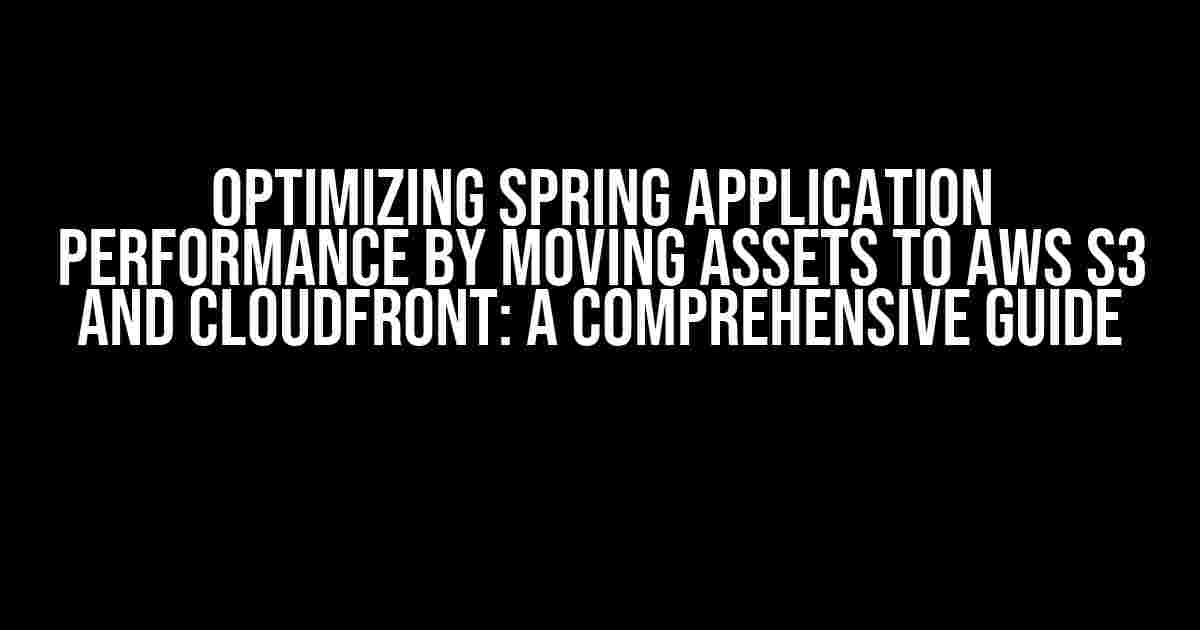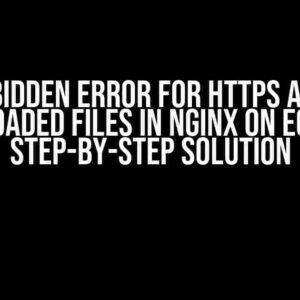Are you tired of slow-loading pages and frustrated users in your Spring-based application? Do you want to breathe new life into your app’s performance? Look no further! In this article, we’ll explore the magic of moving your assets to AWS S3 and CloudFront, and how it can revolutionize your application’s speed and scalability.
The Problem: Slow-Loading Assets
We’ve all been there – waiting anxiously for a webpage to load, only to be met with a spinning wheel of death. The culprit? Slow-loading assets, such as images, videos, and CSS files. These pesky files can bring even the most robust application to its knees, leading to frustrated users and a loss of engagement.
But why do assets slow down our application in the first place? There are several reasons:
- Large file sizes: The bigger the file, the longer it takes to download, leading to slower page loads.
- Server load: Serving assets from your application server can put a significant load on your infrastructure, causing slowdowns and bottlenecks.
- Caching issues: Without proper caching, assets may not be stored in the user’s browser, leading to repeated requests and slower page loads.
The Solution: AWS S3 and CloudFront
Enter AWS S3 and CloudFront, Amazon’s powerful storage and content delivery network (CDN) solutions. By moving your assets to S3 and using CloudFront to distribute them, you can:
- Offload asset storage from your application server, freeing up resources for more critical tasks.
- Leverage the power of a global CDN, reducing latency and improving page load times.
- Take advantage of robust caching mechanisms, ensuring that assets are stored in the user’s browser and reducing the need for repeat requests.
Getting Started with AWS S3
Before we dive into the juicy stuff, let’s get started with setting up an AWS S3 bucket:
- Log in to your AWS account and navigate to the S3 dashboard.
- Click on “Create bucket” and enter a unique name for your bucket.
- Choose a region for your bucket (e.g., us-west-2).
- Set the bucket policy to allow public read access (we’ll cover this in more detail later).
{
"Version": "2012-10-17",
"Statement": [
{
"Sid": "PublicRead",
"Effect": "Allow",
"Principal": "*",
"Action": "s3:GetObject",
"Resource": "arn:aws:s3:::your-bucket-name/*"
}
]
}
Uploading Assets to AWS S3
aws s3 cp /path/to/your/file s3://your-bucket-name/your/file
Configuring CloudFront
With our assets uploaded to S3, it’s time to configure CloudFront to distribute them:
- Navigate to the CloudFront dashboard and click on “Create distribution.”
- Choose “Web” as the distribution type.
- Set the “Origin” to your S3 bucket.
- Set the “Viewer protocol policy” to “Redirect HTTP to HTTPS.”
- Choose a “Price Class” based on your traffic and performance requirements.
- Click “Create distribution” to create your CloudFront distribution.
Updating Your Spring Application
Now that we have our CloudFront distribution set up, it’s time to update our Spring application to use the new asset URLs:
@RestController
@RequestMapping("/assets")
public class AssetController {
@GetMapping("/{assetName}")
public ResponseEntity<byte[]> getAsset(@PathVariable String assetName) {
String cloudFrontUrl = "https://your-cloudfront-url.cloudfront.net/" + assetName;
return ResponseEntity.ok(IOUtils.toByteArray(new URL(cloudFrontUrl).openStream()));
}
}
Benefits of Moving Assets to AWS S3 and CloudFront
So, what are the benefits of moving your assets to AWS S3 and CloudFront?
| Benefit | Description |
|---|---|
| Improved Page Load Times | By offloading asset storage and leveraging a global CDN, you can reduce page load times and improve overall user experience. |
| Reduced Server Load | By serving assets from CloudFront, you can reduce the load on your application server, freeing up resources for more critical tasks. |
| Cost Savings | By using S3 and CloudFront, you can reduce your storage and bandwidth costs, leading to significant savings over time. |
| Scalability | With S3 and CloudFront, you can handle large volumes of traffic and scale your application with ease. |
Best Practices and Considerations
When moving your assets to AWS S3 and CloudFront, keep the following best practices and considerations in mind:
- Use versioning: Use versioning to track changes to your assets and ensure that users receive the latest version.
- Use caching: Use caching to reduce the number of requests to your CloudFront distribution and improve performance.
- Use SSL/TLS: Use SSL/TLS to encrypt data in transit and ensure secure communication between your application and CloudFront.
- Monitor performance: Monitor performance metrics, such as page load times and asset requests, to identify areas for optimization.
- Test thoroughly: Test your application thoroughly to ensure that assets are being served correctly from CloudFront.
Conclusion
By moving your assets to AWS S3 and CloudFront, you can breathe new life into your Spring application’s performance. With improved page load times, reduced server load, and cost savings, it’s a no-brainer. Follow the instructions outlined in this article, and you’ll be on your way to a faster, more scalable application in no time.
Remember to keep best practices and considerations in mind, and don’t be afraid to experiment and optimize further. Happy optimizing!
Related Keywords: Spring Application Performance, AWS S3, CloudFront, Asset Optimization, Page Load Times, Scalability, Cost Savings.
Here are 5 questions and answers about “Optimizing Spring Application Performance by Moving Assets to AWS S3 and CloudFront” in a creative voice and tone:
Frequently Asked Question
Get the inside scoop on how to supercharge your Spring application’s performance by migrating your assets to AWS S3 and CloudFront!
Q: Why should I move my Spring application’s assets to AWS S3 and CloudFront in the first place?
A: By offloading your assets to AWS S3 and CloudFront, you can significantly reduce the load on your application servers, slash latency, and boost page load times. This means a faster, more responsive user experience and a competitive edge for your app!
Q: How does AWS S3 help with optimizing asset storage and delivery?
A: AWS S3 provides a highly durable, scalable, and secure object storage service that’s perfect for storing and serving large volumes of assets. With S3, you can reduce storage costs, simplify asset management, and enjoy built-in versioning and lifecycle management features.
Q: What’s the role of CloudFront in the asset optimization equation?
A: CloudFront is a CDN (Content Delivery Network) that accelerates the distribution of your assets across the globe. By integrating CloudFront with S3, you can cache your assets at edge locations worldwide, reducing latency, improving availability, and providing a lightning-fast user experience.
Q: How do I configure my Spring application to use AWS S3 and CloudFront for asset storage and delivery?
A: You’ll need to update your Spring configuration to use AWS S3 as the asset storage service and CloudFront as the CDN. This involves setting up AWS credentials, configuring the S3 bucket and CloudFront distribution, and integrating with your Spring application using AWS SDKs and APIs.
Q: What kind of performance gains can I expect from moving my assets to AWS S3 and CloudFront?
A: By offloading your assets to AWS S3 and CloudFront, you can expect significant improvements in page load times, reduced latency, and increased availability. Depending on your specific use case, you may see performance gains of 50% or more, which can translate to higher user engagement, increased conversions, and improved customer satisfaction!



